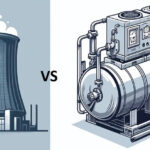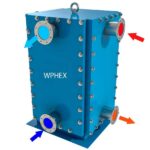Industrial cyclones are mechanical separation devices that use centrifugal force to separate particulate matter from a gas or liquid stream. They consist of a cylindrical body and a conical or a cylindrical outlet, with the particulate-laden gas or liquid entering the cyclone tangentially, creating a swirling flow. The swirling flow generates a centrifugal force that separates the heavier particulate matter from the lighter gas or liquid, which exits the cyclone through the outlet.
Working Principle
Industrial cyclones work on the principle of centrifugal force. They are designed to separate particles from a gas stream by creating a cyclonic flow pattern that causes the particles to be forced to the outer walls of the cyclone. Here’s how it works:
- Gas stream enters the cyclone: The gas stream containing particles enters the cyclone through a tangential or axial inlet.
- Cyclonic flow is created: The gas stream is forced to spin in a circular motion inside the cyclone. This creates a centrifugal force that causes the particles to move towards the outer walls of the cyclone.
- Particles are separated: As the gas stream spirals downwards towards the bottom of the cyclone, the particles are separated and move towards the outer walls of the cyclone due to the centrifugal force.
- Clean gas exits: The clean gas exits the cyclone through a central outlet at the top of the cyclone.
- Collected particles are removed: The separated particles collect at the bottom of the cyclone and are removed periodically through a discharge valve.
The efficiency of a cyclone depends on several factors, including the size and concentration of the particles in the gas stream, the design of the cyclone, and the gas flow rate. Industrial cyclones can be designed with different configurations, such as reverse-flow, axial-flow, or multiple-inlet, to optimize their performance for specific applications.
Industrial cyclones are effective and widely used devices for particle separation in a variety of industries, including chemical processing, mining, and power generation.+
Cyclone Types
Industrial cyclones are devices that are used to separate particles from a gas stream using centrifugal force. There are different types of industrial cyclones, and they can be classified based on their design, application, and operating principle. Here are some of the common types:
- Reverse-Flow Cyclones: These are the most common type of industrial cyclones. They are designed with a tangential inlet that introduces the gas stream into the cyclone chamber, causing it to spin in a circular motion. The particles are separated from the gas stream due to centrifugal force, and they move towards the walls of the cyclone where they collect and are removed.
- Axial-Flow Cyclones: These cyclones have a vertical or axial inlet that introduces the gas stream into the cyclone chamber. The gas stream moves downward due to gravity, while the particles move towards the outer walls of the cyclone due to centrifugal force.
- Multiple Cyclones: These are a group of cyclones arranged in a series or parallel configuration to achieve a higher separation efficiency.
- High-Efficiency Cyclones: These are designed to achieve a higher separation efficiency than standard cyclones. They typically have a longer cone and a smaller inlet diameter, which creates a stronger centrifugal force that can separate finer particles.
- Wet Cyclones: These cyclones use liquid sprays to capture and remove particles from the gas stream. The liquid sprays can be introduced at the inlet or at the base of the cyclone.
- Gas-Solid Separators: These are cyclones designed for applications where the gas stream contains a high concentration of solid particles. They have a larger diameter and a longer cone than standard cyclones to increase the residence time of the gas stream in the cyclone chamber, allowing for more effective separation.
The above are some of the common types of industrial cyclones used in various industries such as mining, chemical, and power generation.
Other types includes
- Conical Cyclones: These are designed with a conical shape that allows for easier collection and removal of separated particles.
- Cylindrical Cyclones: These have a cylindrical shape and are often used for high-temperature gas streams, as they can withstand higher temperatures than conical cyclones.
- Tangential Inlet Cyclones: These have a tangential inlet similar to reverse-flow cyclones, but they are designed with a cylindrical chamber instead of a conical one. They are often used for applications where a high concentration of fine particles needs to be removed.
- Multiple-Inlet Cyclones: These have multiple inlets that introduce the gas stream into the cyclone chamber, allowing for higher flow rates and increased separation efficiency.
- Low-Profile Cyclones: These are designed with a lower height than standard cyclones, making them suitable for applications where headroom is limited.
The choice of cyclone type depends on the specific needs of the application, including factors such as the size and concentration of particles in the gas stream, the desired separation efficiency, and the operating temperature and pressure.
Industrial cyclones uses in industry
Industrial cyclones are commonly used in many industries, including:
- Dust collection systems: Industrial cyclones are often used to remove particulate matter from the air in industrial processes, such as metalworking, woodworking, and cement production.
- Waste management: Industrial cyclones are also used to separate solid waste from waste streams in waste management facilities.
- Minerals processing: Cyclones are often used in mineral processing to separate valuable minerals from waste rock and other unwanted materials.
Selection considerations
When selecting an industrial cyclone, there are several factors to consider to ensure that it is suitable for the specific application. Here are some typical considerations:
- Particle size and concentration: The cyclone should be designed to handle the size and concentration of particles in the gas stream. The smaller the particle size and the higher the concentration, the more efficient the cyclone needs to be.
- Gas flow rate: The cyclone should be able to handle the gas flow rate required for the application. This is typically measured in cubic feet per minute (CFM) or cubic meters per hour (m3/h).
- Temperature and pressure: The cyclone should be able to withstand the temperature and pressure of the gas stream. This is especially important for high-temperature and high-pressure applications.
- Material of construction: The cyclone should be made of materials that are resistant to corrosion, erosion, and abrasion. The material should also be suitable for the temperature and pressure of the gas stream.
- Separation efficiency: The cyclone’s separation efficiency is an important consideration, as it determines the percentage of particles that can be separated from the gas stream. The higher the separation efficiency, the more effective the cyclone is.
- Maintenance requirements: The cyclone should be easy to maintain and clean to ensure that it operates at optimal efficiency. The design should allow for easy access to the interior of the cyclone for inspection and cleaning.
- Cost: The cost of the cyclone is an important consideration, as it should be cost-effective for the specific application. The cost should be compared to the expected benefits, such as increased efficiency and reduced emissions.
The selection of an industrial cyclone requires careful consideration of various factors to ensure that it is suitable for the specific application and meets the desired performance and maintenance requirements.
Advantages and disadvantages
| Advantages | Disadvantages |
|---|---|
| Simple and rugged design | Limited ability to separate fine particulate matter |
| Low maintenance costs | Limited ability to separate particles of similar size and density |
| Ability to handle high gas or liquid flow rates | High pressure drop, leading to increased energy costs |
| Ability to handle large particulate sizes | Potential for blinding or clogging of the cyclone by the collected particulate matter. |
| Relatively low capital costs |
Summary
Industrial cyclones are a widely used and effective mechanical separation device for removing particulate matter from gas or liquid streams in many industries. They are particularly useful in processes where large particulate sizes are present and where fine particulate separation is not a requirement.












